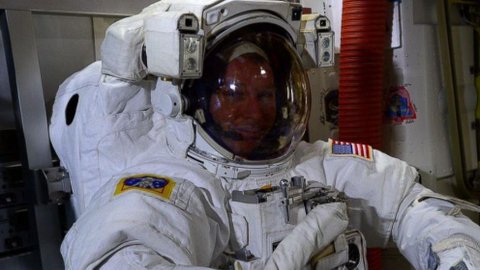
Just a few weeks shy of the 50th anniversary of humanity’s first spacewalk, Expedition 42 Commander Barry “Butch” Wilmore and Flight Engineer Terry Virts are scheduled to venture outside the International Space Station (ISS) on Saturday, 21 February, to begin the first of three EVAs to prepare for a major reconfiguration of the outpost in 2015. Current plans envisage Wilmore (EV1, with red stripes on the legs of his suit for identification) and Virts (EV2, clad in a pure-white suit) to float out of the Quest airlock at about 7:10 a.m. EST to begin 6.5 hours of activity to lay and configure cables in readiness for the arrival of two International Docking Adapters (IDAs), later this year. The latter will serve as the primary docking interfaces for NASA’s Commercial Crew vehicles—the Dragon V-2, built by SpaceX, and the CST-100, fabricated by Boeing—from 2017 onward. The opening EVA—designated “U.S. EVA-29″—was originally scheduled for today (Friday), but was set back by 24 hours, due to a “Non-Standard” element of open work associated with the Extravehicular Mobility Units (EMUs). This has also pushed EVA-30 back by 24 hours to No Earlier Than (NET) 25 February, with EVA-31 retaining its originally planned date of 1 March.
On Wednesday, 18 February, five key personnel members with intimate involvement in the ISS Program and the trio of spacewalks assembled at the Johnson Space Center (JSC) in Houston, Texas, to outline the plans for U.S. EVAs 29, 30, and 31 and to present the bigger picture of how the reconfigured ISS will look by the end of 2015. Kenny Todd, the ISS Operations and Integration Manager, began by noting “a very busy start to the year,” with the successful launch, berthing, and recent return to Earth of SpaceX’s CRS-5 Dragon cargo ship, as well as the recent arrival of Russia’s Progress M-26M and the successful departure of Europe’s fifth and last Automated Transfer Vehicle (ATV-5). He stressed that as many as seven U.S. EVAs will be conducted this year to relocate hardware and establish pairs of docking and berthing ports for unpiloted and piloted visiting vehicles.
However, Mr. Todd began with words of concern, in the form of a “Non-Standard” element of open work concerning the Extravehicular Mobility Units (EMUs) that Wilmore and Virts will use for their three spacewalks. He explained that during a routine coolant loop scrub activity on one of the suits late last year, the fan pump separator—which was also involved in the water-intrusion incident that forced the premature and highly publicized termination of EVA-23 in July 2013—failed to spin-up properly. Troubleshooting identified a possible mechanical binding issue in the separator, and the installation of a new separator has produced no anomalies to date. Unfortunately, last month the same issue arose in a separator on another suit. Since it forms part of a single integrated unit, it is inaccessible to the ISS crew, but both faulty units were returned to Earth last week aboard the CRS-5 Dragon, and initial evaluation points to a binding issue and areas of corrosion. Water chemistry tests suggest that each time the separator is powered up, more water is introduced to the system, and Mr. Todd stressed that his team is looking at improved sampling techniques to avoid damaging fan pump separators in the future.
He concluded that both suits for tomorrow’s EVA-29 are running in fine shape and the corrosion issue is not expected to present a concern for the satisfactory operation of the fan pump separator. However, he pointed out that in the event of an unsatisfactory conclusion to Thursday’s meeting of the Mission Management Team (MMT), EVA-29 may be pushed back as late as Tuesday, 24 February, with the expectation that all three may still be performed before the scheduled return of Wilmore on 12 March. As circumstances transpired, NASA reported late Thursday that a short 24-hour delay to the EVA salvo would be made, citing the need to perform “added analysis” of Wilmore and Virts’ suits.
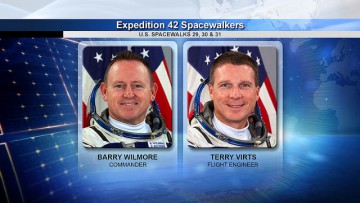
The upcoming spacewalks will be overseen by Lead EVA Officers Karina Eversley (EVA-29), Sarah Korona (EVA-30), and Art Thomason (EVA-31), with Tomas Gonzales-Torres—who previously worked as Lead EVA Officer for STS-125, the final shuttle servicing mission to the Hubble Space Telescope (HST) in May 2009, before being selected as a flight director in October 2011—currently serving as Expedition 42 Lead Flight Director. Mr. Gonzales-Torres pointed out that the three EVAs will each last around 6.5 hours, and that Wilmore will be EV1 for EVA-29 and EVA-30, with Virts taking the EV1 mantle on EVA-31. Their Expedition 42 crewmate, Italy’s first woman in space, Samantha Cristoforetti, will serve as the intravehicular member, responsible for suiting them up in the airlock and for controlling the 57.7-foot-long (17.6-meter) Canadian-built Canadarm2.
The tasks for EVA-29 are described as “IDA Prep” and form part of the “Critical IDA Pathway,” which will see Wilmore and Virts lay cables and utilities in support of two International Docking Adapters (IDAs), which will be delivered to the station aboard SpaceX’s CRS-7 and CRS-9 Dragon missions in June and December 2015. As outlined in a recent AmericaSpace article, two Pressurized Mating Adapters (PMA-2 and 3) will outfitted with the IDAs, thereby converting them from the shuttle-era Androgynous Peripheral Attach System (APAS)-95 docking interface into the new Soft Impact Mating and Attenuation Concept (SIMAC), for use by Boeing’s CST-100 and SpaceX’s Dragon V-2 vehicles.
PMA-2 currently resides at the forward port of the Harmony node—the extreme “front end” of the ISS—and will be fitted with IDA-1. Meanwhile, PMA-3 is situated at the forward port of the Tranquility node, but will be robotically transferred to Harmony’s space-facing (or “zenith”) port in the October 2015 timeframe, in order to accept IDA-2 in December. However, in addition to the need for two ports for Commercial Crew vehicles, two ports are also needed for unpiloted visiting craft. This requires the movement of the 22-foot-long (6.7-meter) Leonardo Permanent Multipurpose Module (PMM) in late July from its current position at the Earth-facing (or “nadir”) port of the Unity node to the forward port of the Tranquility node. This will “open up” a new Common Berthing Mechanism (CBM) at Unity nadir to join the existing interface at Harmony nadir for unpiloted visiting vehicles, as well as ensuring that sufficient clearance is available for the arrival of future craft.
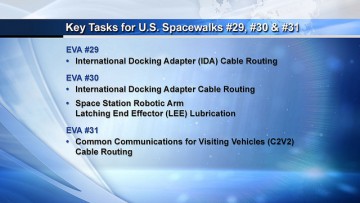
Assuming that this schedule holds, final preparations will get underway early tomorrow morning (Saturday), when Wilmore and Virts will be assisted by Cristoforetti. They will conduct 60 minutes of “pre-breathing” on masks, during which time the inner “equipment lock” of the station’s Quest airlock will be depressed from its ambient 14.7 psi down to 10.2 psi. Upon completion of this protocol, Wilmore and Virts will don and purge their bulky suits and the airlock’s atmosphere will be repressurized to 14.7 psi. This will permit them to enter a nominal pre-breathing regime, lasting 50 minutes, followed by another 50 minutes of In-Suit Light Exercise (ISLE). The latter was first trialed on the STS-134 shuttle mission in May 2011 and involves the spacewalkers flexing their knees for about four minutes, resting for 60 seconds, then repeating until the 50 minutes are up. This technique serves to rapidly remove nitrogen from their bloodstreams, thereby preventing an attack of the “bends.”
At length, the fully-suited pair and their equipment—including the Simplified Aid for EVA Rescue (SAFER) units, affixed to the lower section of their life-sustaining backpacks—will be transferred by Cristoforetti from the equipment lock into Quest’s outer “crew lock.” Hatches between the two locks will be closed and depressurization will get underway. When it reaches 5 psi, the process will come to a halt for standard leak checks, after which depressurization will continue until the crew lock reaches a condition of near-vacuum. The EVA will officially begin when Wilmore and Virts transfer their suits’ critical life-support utilities over to internal battery power. EVA-29 is currently scheduled to begin at about 7:10 a.m. EST, with Wilmore departing the Quest airlock first, followed by Virts.
This will be Wilmore’s second EVA—following his inaugural career excursion on U.S. EVA-28 in October 2014—and he has accrued about six hours and 34 minutes of spacewalking time, whilst Virts has not previously ventured outside his spacecraft in orbit. Wilmore will bring out an IDA Cable Bag and Crew Lock Bag and Virts will carry an identical set of bags. When both men are outside, they will close the thermal cover of Quest and press immediately into critical “buddy checks” to ensure that their suits and safety tethers are properly configured, as well as carrying out an inventory of their tools. Virts will be granted a short period of time to acclimatize to his new environment, before heading to his first work site.
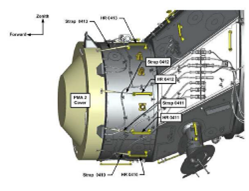
Wilmore will then translate along the Crew and Equipment Translation Aid (CETA) Spur towards the port-zenith side of the U.S. Destiny laboratory, and eventually reaching the forward end cone of Harmony. Meanwhile, Virts will follow a slightly different path, heading around the External Stowage Platform (ESP)-2 on the port side of Quest, and will join Wilmore at the front end of Harmony. The duo will stow their bags and install wire-tie restraints along routes where the cables will be laid. Wilmore will more the existing PMA-2 cabling out of the way, preparatory to the removal of the of two Micrometeoroid Orbital Debris (MMOD) shields. They will release three bolts holding the port-side shield in place and remove it. Virts will then open the Port IDA Cable Bag and Wilmore will disconnect four existing cables—previously used during shuttle dockings and still employed to provide PMA-2 heater power—from beneath the shield and Virts will pass him the four new IDA cables to install. They will then reattach the MMOD shield, then move to the starboard side of Harmony’s forward end cone, where they will switch roles and Virts will lead the disconnection of existing cables and the installation of IDA cables.
Before leaving the starboard cable bag, Wilmore will retrieve a cable—the longest cable, in fact, at about 43 feet (13 meters) in length—and bring it to the port side of Harmony, where he will attach it to a handrail and uncoil it along a “path” toward Destiny, in order to make a pair of connections. He will stow one “leg,” which will eventually lead to PMA-2 after its relocation, and then secure the second leg with wire ties to await the arrival of IDA-1. Elsewhere, Virts will unpack and route cables from the Port IDA Cable Bag to restore power and telemetry for the PMA-2 heaters, each of which carries “legs” destined for the forward end of the adapter, on zenith and nadir faces. Wilmore will handle the port nadir route and Virts the starboard zenith route. Current plans expect two cables to remain in the Starboard IDA Cable Bag at the end of EVA-29, with the expectation that they will be installed at the start of EVA-30, but if Wilmore and Virts hustle along in their tasks it remains possible that more of the cable work may be completed tomorrow.
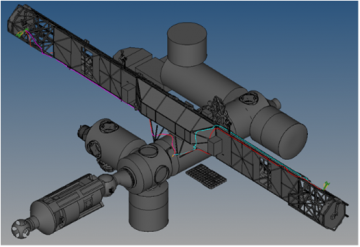
In summing up EVA-29, Ms. Eversley described the laying of IDA-1 power and data cables as “the most complicated cable-routing task that we have performed on the ISS to date.” Adding specific complexity to the task is that the two Harmony end-cone MMOD shields—designated “C2-05” and “C2-02”—have never been opened by spacewalkers, although circumferential shields have been accessed in the past. When they were designed, the connectors underneath the shields were not intended for EVA access and as a result were not built as “EVA-friendly,” but rather had more commonality with intravehicular connectors. Ms. Eversley demonstrated the pull-back lever of an EVA-friendly connector, which is relatively straightforward to handle with bulky space suit gloves, and highlighted the difficulty associated with the internal connectors, which require the 360-degree rotation of a collar, then the “tricky” alignment of keying features to mate them, followed by the rotation of the collar back into position. She described rotating the collars as “difficult to do” in a space suit, but stressed that similar connector types were used on the HST servicing missions and similar tools are aboard to provide additional leverage, if needed.
Returning to the Quest airlock after a baselined 6.5 hours, Wilmore and Virts are expected to perform two more EVAs on Wednesday, 25 February, and Sunday, 1 March, both of which will be extensively previewed by AmericaSpace in the aftermath of EVA-29. In total, more than 364 feet (110 meters) of cable will be routed to prepare for the arrival and installation of the IDAs in June and December. During EVA-30, Wilmore will work on the completion of the cable tasks, whilst Virts—using a Grease Gun and Ballscrew Lubrication Tool (BLT)—will lubricate five “sticky” areas of the Latching End Effector (LEE) on Canadarm2. This latter task will require close co-ordination with Samantha Cristoforetti, who will be at the controls and will present the robotic arm close to Virts for this intricate task. Additional EVA-30 tasks include Wilmore preparing the forward and aft CBMs of the Tranquility node for the relocation of the Leonardo PMM in July and the arrival of the Bigelow Expandable Activity Module (BEAM) in September. Finally, EVA-31 will see the installation of four antennas and three sets of retroreflectors on two booms on the port-side P-3 and starboard-side S-3 trusses to support the Common Communications for Visiting Vehicles (C2V2) architecture.
Want to keep up-to-date with all things space? Be sure to “Like” AmericaSpace on Facebook and follow us on Twitter: @AmericaSpace
Missions » ISS » EVA 29 »



A piece of space history trivia – Alexei Leonov will have become the third cosmonaut to reach the 50th anniversary milestone (March 18, 2015) after Valery Bykovsky and Valentina Tereshkova (June 1963-2013).